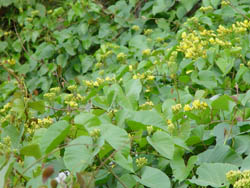
In south China's Guangdong Province, a group of CAS botanists have recently found a new invasive plant species that poses significant threat to local forests.
Native to the tropical regions of Hainan and Guangxi in south China, Jing zhong teng
(Merremia boisiana (Gagnep.) Oostry) is a climbing vine with bell-like white flowers in Convolvulaceae or morning-glory family. In its original habitats, the vine's growth is suppressed by its natural enemies. In the south China's subtropical region of Guangdong where it meets no natural restraints, however, the alien species can multiply its populations at an exceedingly high speed. Its fast outgrowth indulges itself in an unrestrained spree, giving rise to a green and dense canopy which blankets native shrubs even 10m-tall arbors until the latter are suffocated to death by it.
The discovery was made by Prof. Chen Binghui and his colleagues from the South China Botanic Garden, a plant research arm affiliated to CAS, in a field investigation in the forest of a suburban village in the outskirts of Guangzhou, capital city of Guangdong Province.
The damage the "pretty tree killer" causes is greater than those made by South American Climber
(Mikania micrantha), another invaded species notorious for its destructive role in the bio-invasion, according to the scientists in the investigation. The vine's ravage is concentrated on the saplings in their sub-adulthood in a secondary forest. In the tree farm, where the murderous vine had been first discovered, farm workers applied herbicidal chemicals to get rid of it but in vain. Also, manual felling cannot work as the vine cannot uprooted thoroughly. Three months have been passed since new drugs were introduced in suppression of the vine, so far no remarkable effects appear.
Prof. Chen warns the forest administration should be prepared for more damages may be inflicted by the vine in the forests. To deal with the invasive species, Prof. Chen offers the following measures.
Before any more effective methods are available, one way to exterminate the vine is to cut off their stems and dig up their roots.
The second step is an all-round investigation over the province to make clear the real situation of the vine's distribution for the authorities to launch a campaign to wipe it out in time.
The third recommendable step is to introduce natural enemies as a measure of biological prevention is always effective.
The fourth is to develop environmentally friendly herbicides and the attempt to turn the bane into benefits, such as the employment of its leaves as livestock’s forage and its seeds and tubes used as medicinal materials.





